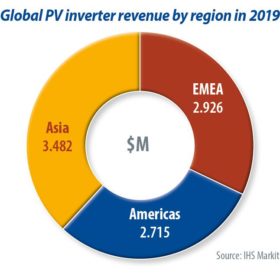US and UK discover lithium as IHS Markit projects battery price to fall below $100/kWh
The business intelligence firm has projected storage costs will continue their downward trajectory on the back of product and process optimization. That will favor a higher adoption rate in automotive and grid applications, the analysts say. Elsewhere, discoveries of lithium in the U.S. and the U.K. have raised hopes for lower raw material costs and more supply chain diversity.
Texas will outshine California in 2020
The Covid-19 pandemic continues to cast a cloud on industries around the world, but the U.S. utility-scale solar segment is still growing, writes IHS Markit solar analyst Maria J. Chea. Around 3 GW of solar PV is set to be installed this year in Texas alone, but opportunities also abound across several other southern U.S. states.
Covid-19 weekly round-up: Differing opinions on energy storage fall-out, a trade show update and some surprisingly positive financials
Negative second-quarter updates from China and uber-low new-solar figures from India, however, show the world is far from out of the woods yet.
Energy storage investment to approach $10bn in 2025
Analyst IHS Markit has predicted storage will rebound this year following its first year-on-year decline in 2019. The technology is being rolled out at pace despite Covid-19 with state-level policies set to keep the US the global capital for the next five years.
Energy storage and network reinforcement
As renewables penetration increases, transmission and distribution (T&D) infrastructure will require significant reinforcement. Battery storage is becoming a key alternative to traditional ways of reinforcing network infrastructure, because it is fast to deploy, can provide multiple services, and often comes at a lower capital cost. IHS Markit analyst Oliver Forsyth delves into the additional value streams that strengthen the case for grid-connected batteries.
Green hydrogen to reach price parity with grey hydrogen in 2030
IHS Markit’s latest report looks at a wave of new investments in large-scale projects. Economies of scale and technological improvements, as well as renewables deployment, could make green hydrogen price-competitive with grey and blue hydrogen.
Emerging markets and innovation: Twin pillars of the solar tracker market
Global solar tracker shipments reached new record levels in 2019, exceeding 31 GW, up 55% year on year. Exceptional demand in the United States – as well as multiple gigawatt markets in Brazil, Mexico, Chile, Spain and Australia – helped propel the market to new heights, writes Cormac Gilligan, associate director at IHS Markit.
Record shipments push global solar PV inverter market past $9 billion in 2019
The PV inverter market achieved record shipments in 2019, writes IHS Markit’s Miguel de Jesus, driven by booming shipments in key markets such as the United States, Spain, Latin America, Ukraine and Vietnam. Revenue rose rapidly, surpassing the $9 billion mark in 2019 for the first time.
Asian buoyancy floats solar
Global floating PV installations are set to jump by 143% from 2019 to hit more than 900 MW of annual capacity additions this year, according to IHS Markit’s Floating PV Report – 2020. Growth has been driven in recent years by a surge in the number of floating PV systems installed in countries such as China, South Korea, Japan, and the Netherlands, with total global installed capacity reaching about 1.5 GW at the end of 2019. IHS Markit Research Manager Cormac Gilligan and Senior Analyst Chris Beadle examine how these countries have taken the lead, with developers building large quantities of floating PV, while also installing pilots to better understand the technology and test its capabilities and cost-effectiveness.
Decommissioning coal – an opportunity for energy storage?
Coal has underpinned power generation for more than a century as a cheap, reliable and well understood technology, writes IHS Markit analyst George Hilton. Decommissioning of coal generation, in light of global efforts to reduce carbon emissions, will radically change the energy landscape and potentially leave a substantial gap to be filled by energy storage technologies.










